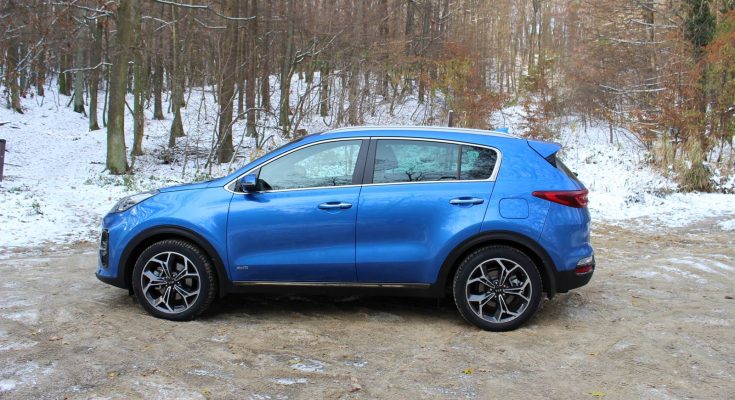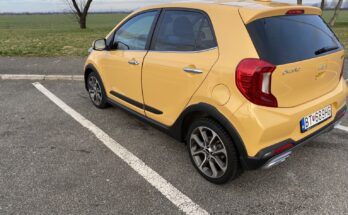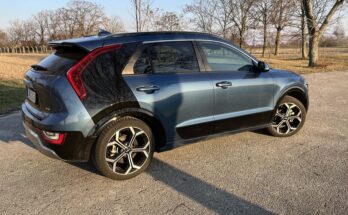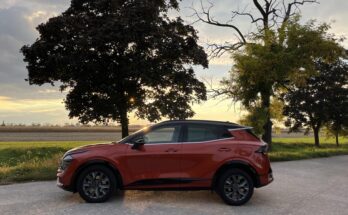Kia Sportage of the fourth generation underwent a facelift. The engines and transmission have changed, microhybrid technology has been added, which should bring lower consumption and emissions. However, interventions in the design are only minimal. We are testing the top GT-Line equipment with a 2.0 CRDi engine and a new 8-speed automatic transmission.
From the outside
The unusual but successful exterior design did not need to be changed too much. The front part with the high lights makes the Sportage unmistakable and everyone recognizes it from afar. Even before the facelift, the GT-Line equipment brought a new element in the form of four small LED lights that served as fog lights and the automaker called them "ice cubes". After the new Ceed, the tested model also nicely incorporated them into the main lights and they are used for daytime running lights. It is also the main element by which you recognize the Sportage after the facelift.
There are not many other changes. The front bumper received a different shape, a chrome bar and turn signals were added. On the side, apart from the fuel tank cap, nothing has changed, if I don't count the new, beautifully shaped 19" wheel rims (with 245/45 R19 tires). A chrome strip was added at the back, the shape and graphics of the taillights changed. I wanted to praise the nice exhaust tips, but a look from below unfortunately revealed that they are fake.
The facelift helped the car and softened the front part a bit. Personally, I like the car from the side and especially from the back, while I would highlight the taillights, gently connected by a light strip. Despite its compact dimensions, the car looks powerful, but not aggressive. The new blue paint adds freshness to the car and clearly suits it.
Inside
The interior underwent even smaller changes. They are visible on the steering wheel, vents and some controls. The 8" touchscreen infotainment display remained integrated in the dashboard and did not become a free-standing "tablet" like the smaller Ceed . It is placed high enough and is readable even in direct sunlight.
I praise the asymmetrical center console with a practically cut-out place for the driver's right leg. The number of buttons seems chaotic at first glance, but after a while I got used to it and appreciated this control. The steering wheel is nicely shaped and well made, including buttons with a good response. It has an above-average thick bezel and does not obscure the view of the instrument panel. The easy-to-read dials of the tachometer and speedometer are complemented by a 4.2" color LCD display, displaying rich on-board computer data. The analog display of coolant temperature and fuel level in the tank was also not forgotten.
I like the interior trim of the doors, but I find it impractical to use piano lacquer on exposed areas. The doors are heavy and appear massive, but I missed the threshold cover, which does not contribute to the cleanliness of the pants when getting into the car. The high dashboard is made of a mixture of softened and hard plastics with a nice structure. The automatic transmission selector has a practical, but somewhat outdated shape. I was satisfied with the development of the central tunnel and also with the pleasant, although non-positionable, armrest. Full leather seats stitched with red thread offer both heating and cooling and promise a comfortable seat behind the wheel.
Driving
Getting into the car is comfortable thanks to the not very wide thresholds. The front seat cushions are wide and long, the backrests are high enough. Overall, they provide adequate comfort, but in my opinion, they do not reach the quality of the seats used in the larger Sorento model . I would also welcome a height-adjustable lumbar support. The seat is higher, but with the legs sportily stretched forward. The stroke and placement of the pedals is fine, but it took me a while to get used to the slightly larger distance between them. I appreciate the sufficiently large and padded left leg rest. Overall, I was satisfied with the sitting behind the wheel thanks to a sufficiently wide range of steering wheel adjustment.
I have no reservations about the ergonomics of the individual controls, except for the mentioned number of buttons on the center console. Their red backlight in the dark was distracting to me. The relatively close location of the automatic selector next to the driver is also a matter of habit.
There is enough space for legs, shoulders and head. I was satisfied with the already mentioned armrest, as well as with the soft rest in the door. The view in all directions is unproblematic and supported by large rear-view mirrors.
Infotainment is the same as in other models of the brand. The touch screen has a fast response, large icons and offers a lot of functions in a user-friendly package. I appreciated the Android Auto/Apple Car Play support and thus the Waze navigation, which I enjoyed using.
Ride
Driving in the new Sportage is very pleasant. The chassis provides sufficient comfort and holds even during dynamic driving. The car completely ignores smaller bumps, and transfers larger ones to the interior only minimally. Relatively small inclinations of the car allow the driver to go through the corner at a higher speed. However, the non-disabled stabilization system will prevent the attempt to approach the limit. Despite this, you can have fun with the car especially on a slippery surface, where when exiting a corner under full throttle, you can feel the transfer of torque to the rear wheels in a gentle skid. The considerable weight of the vehicle, 1672 kg, and the well-tuned multi-element rear axle ensures fair holding of the rear wheels even on uneven surfaces.
The car was powered by a refined diesel four-cylinder with a volume of 1995 cm3, a maximum power of 136 kW at 4,000 rpm and a torque of 400 Nm between 1,750 and 2,750. The unit is connected to a 48-volt lithium-ion battery, which is located in the rear of the vehicle and reduces the volume of the luggage compartment. The work of recuperation during deceleration and the transfer of energy from the batteries to the system can be monitored on the display of the on-board computer. The mild hybrid should contribute to the dynamics of the engine and ensure its economical operation. Engine noise is decently suppressed and can only be heard during acceleration at higher speeds.
The engine is mated to a new 8-speed transmission with a hydrodynamic converter. In the recently tested Sorento model in conjunction with the more powerful 2.2 CRDi engine, I was satisfied with its work. However, cooperation with the engine in the tested Sportage was no longer ideal. Although the shifting of individual gears was always smooth and gentle, the gearbox often hesitated during acceleration, which gear to select. In addition, at lower speeds, it allowed the revolutions to drop below 1200, to which the engine responded with a bubbling sound and gentle vibrations. Sport mode partially solved these problems, because it kept the revs higher and thus helped the transmission to make faster decisions.
The power steering is set relatively stiff. It suited me except for the change in its resistance when passing through the central axis. After a while, I got used to it and stopped being aware of this "strangeness". I appreciate the directness of the steering and its decent steepness, as the revolutions between its extreme positions reach a value of 2.5. Almost no manufacturer provides feedback from the front wheels in the compact SUV class, and Kia is no exception.
Except for some minor flaws, I was satisfied with driving the renewed Sportage. However, I was surprised by the average consumption, which I achieved in normal brisk driving with a slight predominance of highways. In my opinion, 9 l/100 km would be too much even without the use of mild hybrid technology. In addition, the 55-liter tank means a range of only 600 km per refueling. However, since it is a new car with low mileage, it is assumed that the consumption will be adjusted to a more acceptable level over time.
The excellent maneuverability in the city did not surprise me thanks to the compact dimensions of the car. Parking is assisted by a camera system allowing a bird's-eye view of the car. The chassis handles road irregularities with ease and decently filters out even larger irregularities. A high sitting position and sufficient glazing helps orientation in narrow streets. Of course, consumption depends on current traffic and can exceed 12 l/100 km.
In the districts, I achieved an average of 8.6 l/100 km with brisk driving. As with other Kia models, I was convinced of the high level of driving assistants. In heavy snow, I appreciated the option to turn off the adaptive cruise control function. The lane-keeping assistant can autonomously copy even sharper turns, but in my opinion, at the same time, it interferes too violently with the steering. When driving at night, I was satisfied with the performance of the front LED lights, but I was surprised by the need to manually adjust their height.
Driving on the highway while observing the speed limits increased the consumption from the tank to a value of 10 liters. Slowing down on the expressway at a speed of 100 km/h reduced consumption to 7.7. I was pleasantly surprised by the soundproofing of the car from the chassis and aerodynamic noise. The stability of the car on the highway is exemplary even in strong side winds.
Ground clearance of 172 mm and 19" wheels discouraged me from off-road driving. However, the car managed the smaller snow-covered hill without protest.
Practical side, price
At my height of 185 cm, I sat comfortably "behind myself", while I had a reserve of about 5 cm in front of my knees. There is just as much space above the head. The rear seats are comfortable, with sufficiently high backrests. I appreciated the possibility of positioning them.
The problem occurred when trying to anchor a child seat in the back seat. The attempt was not successful due to the deep location of the IsoFix mounts and the anatomical shaping of the backrests. The interior provides a number of voluminous and well-usable storage compartments. With the Sportage with the tested mild-hybrid engine, it is necessary to expect a limited luggage space, the volume of which is reduced to 439 liters. Nevertheless, it is well usable and provides a flat surface when the rear seats are folded down.
The price of the tested model is EUR 36,990 + EUR 1,890 for the GT-Line Pack + EUR 550 for the metallic finish. I consider the total price of EUR 39,430 too high, even if it is reduced by EUR 1,300 at the time of the test. The question is whether it would not be more advantageous to save 3300 EUR and consider the version with the 1.6 T-GDi petrol engine. During the test of the Hyundai Tucson model with this unit, I achieved only one liter higher consumption on the same routes. Simple calculations will indicate that the higher price of the diesel version will equal the gasoline version only after driving approximately 160,000 km.
Verdict
Except for the higher consumption of the mild-hybrid engine, I was satisfied with the car. It provides a combination of good driving characteristics, a modern and well-crafted interior and, last but not least, an interesting design. If interested in a compact SUV, I would definitely shortlist it. However, I would probably lean towards the aforementioned 1.6 T-GDi gasoline engine, which provides better dynamics, has a faster transmission and, taking into account the price difference, only negligibly higher consumption.




